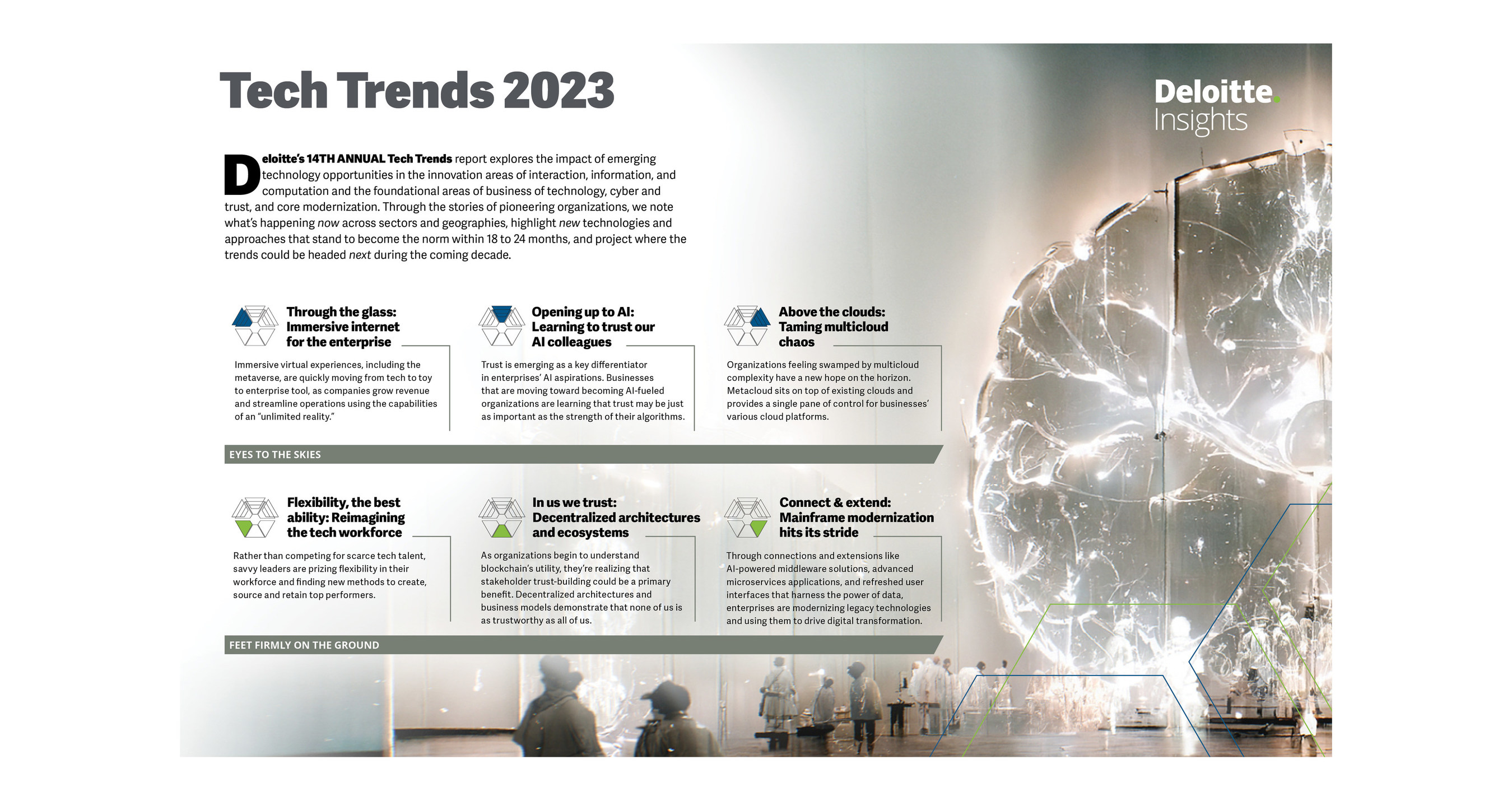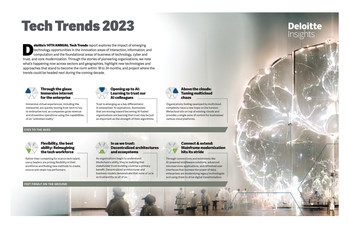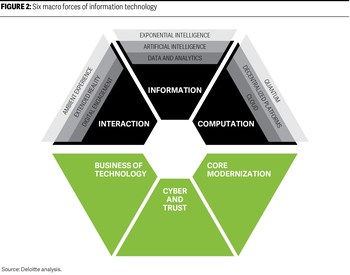
Deloitte’s 14th Annual Tech Trends Report Finds Trust at Center Stage, Illuminates the Path from Now to Next for Business Leaders
NEW YORK, Dec. 7, 2022 /PRNewswire/ —
Key takeaways
- As economic disruption shifts business and technology strategies, enterprises will look towards the IT lessons of the past to help shape their future.
- Report identifies advancements across six macro forces consequential to business transformation over the next 18 to24 months.
Why this matters
As enterprises continue to push the fast-forward button on emerging technology adoption amid escalating economic disruption, Deloitte’s 14th annual Tech Trends report details how technology leaders are using lessons from the past to build tech-forward, future-friendly strategies, today. This year, trust is emerging as the central element across all 2023 Trends, as enterprises increasingly recognize that business outcomes are limited less by technological capability, and more by the comfort and confidence in adoption and impact.
Anchored in the three core tenets of information technology (IT) that have endured over the past 180+ years: interaction, information and computation, Tech Trends 2023 chronicles the shared march towards three convergent endgames of simplicity, intelligence and abundance.
- Interaction moves towards simplicity: While the technologies that drive human-computer interactions are becoming more complex, user experiences will continue to become simpler.
- Information evolves towards intelligence: As information systems advance, machine intelligence will become increasingly well-rounded.
- Computation towards abundance: As machines miniaturize, virtualize and decentralize, the capacity to solve seemingly intractable problems will continue unabated.
Critically, established organizations should balance today’s systems as they navigate towards what’s next. As such, the report chronicles emerging trends in three additional categories: The business of technology, cyber and trust, and core modernization. Taken together, these three grounding forces balance the aforementioned three pioneering forces.
Key quotes
“Tech Trends 2023 applies research, Deloitte’s unique history in working with global organizations across industries, and the combination of business and technology experience to predict how enterprises navigate to what’s next. Instead of betting on the future, Deloitte is helping clients build confidence in harnessing disruptive technologies to make their innovation ambitions real. Our insights for this year’s report have revealed a number of truths: transformation should be business and mission led, powered by AI, fueled by technology providers big and small, with a goal to make and shape new markets. Tech Trends 2023 can help organizations nurture what we have now as we navigate to what’s next, building something significant, sustainable and future-friendly for tomorrow.”
– Bill Briggs, global chief technology officer and principal, Deloitte Consulting LLP
“Mark Twain reportedly observed that, ‘History doesn’t repeat itself, but it often rhymes.’ There are clear call-backs in this year’s Tech Trends to historical technology inflection points such as the GUI, the internet, and mobility. Each trend offers opportunities to test new approaches and learn and transform both technology and business models. In navigating these new pathways, we should strive to achieve a balance between our pioneering spirit and our protective mandate. Done well, we can promote the primacy of business to IT, minimize risk, maximize the value of our investments and work to build trust within our business ecosystems.”
– Mike Bechtel, chief futurist and managing director, Deloitte Consulting LLP
Deloitte Tech Trends 2023
Three enduring eternities: Pioneering and innovative, these trends center around advancements in interaction, information and computation, and focus on how trust influences enterprise risk, human-computer interaction and data integrity:
- Through the glass: Immersive internet for the enterprise: Tangible, conversational and virtual interfaces will shift beyond the screen to an immersive internet that will manifest in three ways: extended reality, including a consumer-facing metaverse experience; enterprise simulation, using digital twins of our physical assets to prototype and experiment; and augmented workforce experience – across recruiting, productivity, learning, and more. With the ability to get digital richness in the physical space, companies are trusting in the promise of an immersive internet to build lucrative business models around the unique capabilities afforded by “unlimited reality.”
- Opening up to AI: Learning to trust our AI colleagues: With AI tools increasingly standardized, organizations are realizing that competitive gains will best be achieved when there is high confidence that AI is delivering the right analytics and insights. To build trust, AI algorithms must be visible, auditable and explainable, and workers must be involved in AI design and output.
- Above the clouds: Taming multicloud chaos: 10 years of heterogeneous multicloud deployments has created considerable complexity in cloud management. Enterprises are bringing simplicity and visibility through a common layer of abstraction and automation (called metacloud or supercloud). With these cross-cloud services managing operations, governance and security, organizations can take full advantage of cloud versatility, elasticity, flexibility and scalability.
Three foundational forces: These trends center on the macro forces of the business of technology, cyber and trust, and core modernization as organizations pursue what’s next:
- Flexibility, the best ability: Reimagining the tech workforce: Modern engineering is at the heart of business strategy. But rather than competing to hire the same finite pool of 10x engineers, savvy organizations are creating new IT structures and roles to better align with available talent supply. By prioritizing values, cultural fit and aptitude, and trusting talent to flex their curiosity and versatility in becoming serial specialists over extant skills, this approach is resulting in an improved talent experience and business outcomes.
- In us we trust: Decentralized architectures and ecosystems: Even with market volatility surrounding cryptocurrency, the enterprise potential of blockchain and digital assets is continuing to grow. In a world of eroding trust and a proliferation of misinformation, the new approach to validating data and transactions is trustless, with a public blockchain as the system of record. As blockchain-powered “trustless ecosystems” evolve into Web3, they’re becoming key to the creation and monetization of digital assets.
- Connect & extend: Mainframe modernization hits its stride: Once considered a breed bound for extinction, mainframes are enjoying a quiet renaissance. Today, enterprises are using middleware to link core systems to new-generation computing technologies such as graphics processing unit (GPU)-based supercomputers, as well as innovative user interfaces that provide promising new paths into cloud-based analytics, AI and ML. This core optimization strategy is breathing new life into legacy systems, extending the trust in and value of their computing power, data stores and functionality.
Beyond Tech Trends 2023: Widening the aperture: From InfoTech to xTech
Since 2010, Deloitte’s Tech Trends team has been entrenched in researching, sense-making, and shaping how emerging technologies are transforming and disrupting businesses in new and unpredictable ways. Within this year’s dialogue, several pioneering leaders drew attention to an extended set of technologies, or xTech, which to date have been separate from IT. As such, this year’s report begins to explore the possibilities that may take hold as six technologies, spaceTech, bioTech, neuroTech, robotTech, climateTech and energyTech, may eventually rival IT, with the idea that these emerging disciplines represent a broad spectrum of potentially transformational business applications on the next technological horizon.
To download the full report, visit Deloitte Tech Trends 2023.
Connect with us on Twitter at @DeloitteOnTech or on LinkedIn.
About Deloitte
Deloitte provides industry-leading audit, consulting, tax and advisory services to many of the world’s most admired brands, including nearly 90{5376dfc28cf0a7990a1dde1ec4d231557d3d9e6448247a9e5e61bb9e48b1de73} of the Fortune 500® and more than 7,000 private companies. Our people come together for the greater good and work across the industry sectors that drive and shape today’s marketplace — delivering measurable and lasting results that help reinforce public trust in our capital markets, inspire clients to see challenges as opportunities to transform and thrive, and help lead the way toward a stronger economy and a healthier society. Deloitte is proud to be part of the largest global professional services network serving our clients in the markets that are most important to them. Building on more than 175 years of service, our network of member firms spans more than 150 countries and territories. Learn how Deloitte’s approximately 415,000 people worldwide connect for impact at www.deloitte.com.
|
Deloitte refers to one or more of Deloitte Touche Tohmatsu Limited, a UK private company limited by guarantee (“DTTL”), its network of member firms, and their related entities. DTTL and each of its member firms are legally separate and independent entities. DTTL (also referred to as “Deloitte Global”) does not provide services to clients. In the United States, Deloitte refers to one or more of the US member firms of DTTL, their related entities that operate using the “Deloitte” name in the United States and their respective affiliates. Certain services may not be available to attest clients under the rules and regulations of public accounting. Please see www.deloitte.com/about to learn more about our global network of member firms. |
SOURCE Deloitte Consulting LLP




